Yellowstone Park Camping Companies:
Shaw and Powell Camping Company
Copyright 2009 by Robert V. Goss. All rights reserved. No part of this work may be reproduced
or utilized in any form by any means, electronic or mechanical, including photocopying, recording or by an
information storage and retrieval system without permission in writing from the author.

Click Here for Map of Yellowstone National Park - 1916 NPRR
Click Here for a Shaw & Powell map of Yellowstone - 1914
The Shaw and Powell company was permitted to operate 'movable camps' in Yellowstone in 1898. The firm was started by Amos Shaw and J.D. Powell (John D. Powell) with headquarters in Livingston, Montana. many members of the Shaw family were involved, including son Walter Shaw, Chester Shaw, Leo D. Shaw, and Jesse Shaw. They initially brought guests into the park from the north entrance and built the Shaw Hotel in Gardiner to serve their guests after their arrival on the Northern Pacific train and prior to their departure. They transported their guest in wagons and coaches around the park to view all of the major scenic attractions. They carried all their camping materials with them and setup nightly camps in various locations that featured good grass for grazing and adequate water resources. In 1908 the Union Pacific RR began service to what is now West Yellowstone (known at the time as just Yellowstone) and the company soon began transporting their guests from the west entrance.
|

Undated view of an early Shaw & Powell camping coach |
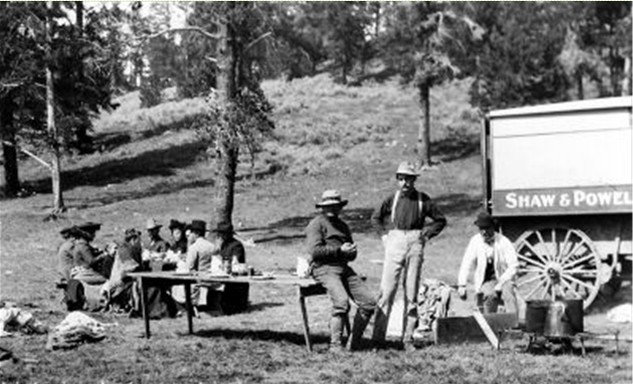
Lunch time along the tour route in Yellowstone |
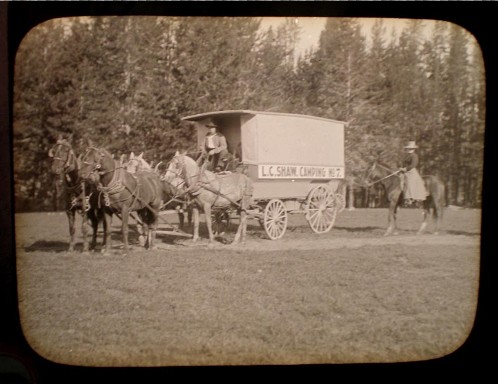
Early lantern slide view of a Shaw & Powell coach, labeled "L.C. Shaw Camping No. 7." L.C Shaw was Leo C., son of Amos Shaw. |
 |
In 1912 the company bought out the Robert C. Bryant Camping Co., also known as Bryant-Spence Camping Co., that had been operating camping tours from the west entrance since 1903. The sale also included the Bryant Way hotel in West Yellowstone, which then became the Shaw & Powell Hotel. It was located on Park Street, one block east of the UPRR Depot, near the entrance to the park. |
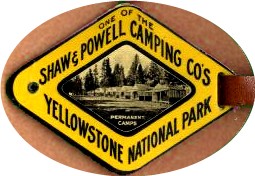 |
Shaw and Powell were given permission by Interior to build a permanent camp in 1912 at Willow Park, near the current Indian Creek campground. In 1913 permission was received to build permanent camps at all major locations. They operated their own stage lines to transport their customers around the park, utilizing Mountain Stages built by the Studebaker Co. Log kitchens, dining rooms, and storerooms were built at all night camps in 1913-15. By 1916 camps were located at Willow Park; Nez Perce Creek; Upper Basin (current O.F. Lodge site); Lake Outlet (current Lake Lodge site); Canyon (Uncle Tom's Trail parking lot); and Tower, with lunch stations near the base of Gibbon Falls and at West Thumb. |
Description of the Shaw & Powell Transportation Co. from the Livingston Enterprise Souvenir (Montana) in 1900
The firm of Shaw & Powell, hunting camp outfitters and Yellowstone Park guides, are prepared to take parties of any size from five to one hundred, through the National Park, or on hunting trips through Jackson Hole country, Hell Roaring region, Buffalo Fork or Suce creek - in fact to any and all points in Montana or Wyoming where there is an abundance of game, such as elk, bear, deer, mountain lion and sheep, antelope, chicken and grouse. Their pack trains are made up of good horses and plenty of them, who are well able to stand the high latitude and long trips. Thes outfits include cots to sleep on, which means sleeping off the ground and everybody made as comfortable as possible. . . . Amos Shaw, the senior member of the firm, is one of the oldest guides in the park, having assisted in surveying its lake and rivers, laying out the roads and sounding the depths of the geysers and hot pools. . . . They carry a full outfit on each trip, including the best cook and the best of food. Shaw & Powell employ only gentlemen, and succeed where others fail. |
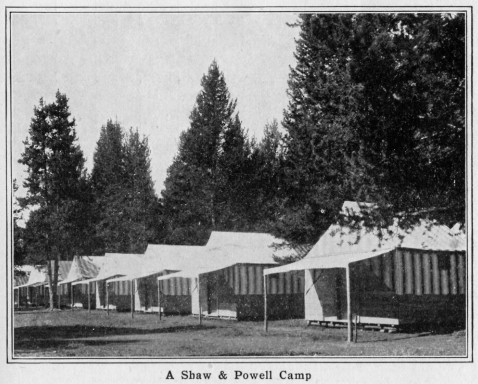 |
 |
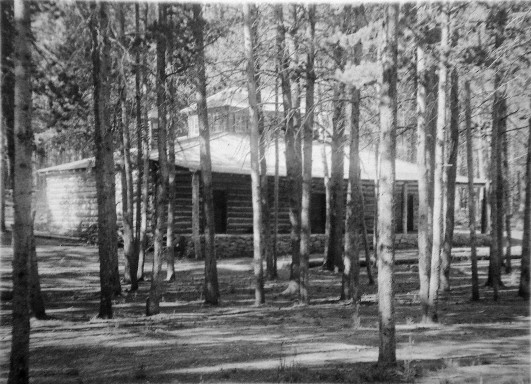 |
| "A Shaw & Powell Camp" from an early Haynes Guide. At this unidentified location, the canvas tens sit atop a wooden platform with wood wainscoating partly up the sides. |
Gibbon Lunch Camp in 1917. This camp was closed after the 1916 season. The building with the cupola was probably the lunch hall.
[Photo courtesy YNP Archives, Jack Haynes Photo 10-F1] |
The Shaw & Powell Lunch pavilion at Willow Park. This area became a permanent camp in 1912, a year prior to the other S&P night camps.
[Photo courtesy YNP Archives #6812] |
A Description of Camping Life with Shaw & Powell in 1903,
Before the days of their Permanent Camps.
Excerpts from an article in The Oxford Mirror, Aug. 13, 1903
Oxford Junction, Iowa
"It is the good fortune of myself and Harold to be with the Shaw & Powell camping company, which numbers twenty-eight tourists and fourteen helpers or 'savages' as they are called in camp parlance. The camp is moved every day, and all the tents, cots and bedding are piled up on an immemse baggage wagon, drawn by four horses. Besides this there is a traveling kitchen, containing range, sink and all sorts of receptacles for holding everything needed in a kitchen. During the travel of the camp from one point to another, the cook prepares for the next meal. There is also a wagon which carries the food supplies, which is called the 'mess wagon.' Last night a bear made a visit to our camp, and in the morning this particular wagon was a sorry looking sight.
There are five coaches carrying our party . . . and Mr. Powell gives us every opportunity to see all there is to be seen in the park. He is a most accomodating and pleasant gentleman, and takes great pains for the comfort of his guests. Every trip through the park is personally conducted, either by Mr. Shaw or Mr. Powell, so that the traveler is always assured of first-class treatment in going with this company.
When we reach our camping place for the night the large dining tent is at once set up, so that the cooks can begin getting the evening meal. Then one man starts out with a horse to drag in logs to make a camp fire, while several more set up the sleeping tents. These are set as closely together as possible, and in a semi-circle, with the campfire in the center. After supper we all gather around the fire and tell stories, play games or sing songs.
Besides the two cooks, there are twelve young men with Mr. Powell, who help about the camp in various ways - driving the coaches and wagons, putting up tents, waiting on table, etc. I think with one exception they are all college boys who are spending their vacation in this way . . . They are all typical college boys, and with their music and college songs, add much to the pleasure of the trip."
|
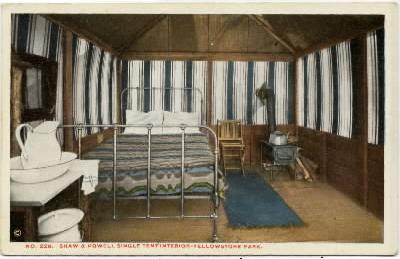
[Interior of single tent cabin
Haynes Postcard view #228] |

[Brass luggage tag from the author's collection.
Size 1-1/4x1-3/8"] |
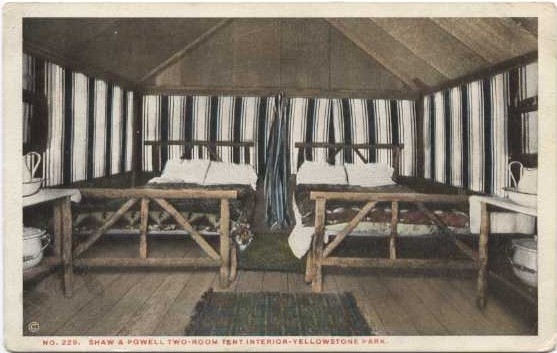
[Interior of double tent cabin
Haynes Postcard view #229] |
Geyser Region of Yellowstone Visited by Waterloo Tourists
"Camp Life"
The Waterloo (Iowa) Evening Reporter, August 20, 1910
“Everybody is up bright and early in the morning ready for a big day sightseeing. Jim Rainbow is our alarm clock and he surely does his part well as there is no more sleep for the party after he has his eyes open. Then comes the call for breakfast and it is not a light one, potatoes, bacon, breakfast food, pancakes and syrup, etc. While the guests are eating their breakfast the tents are being taken up. Each bed is numbered so that we all have our own bed every night. This wagon is started off to our next campground and they have everything in readiness when we arrive in the evening.
“The cook wagon is a marvel. It has a range and places for provisions for the six and a half day’s trip besides all the cooking utensils and dishes. The cook wagon moves on as soon as they get their dishes washed to the place where we stop for lunch.
“The tourists leave camp about seven or half past on their day’s trip. We go from 11 to 13 miles before lunch. At 12 o’clock we are all ready for another meal and when they told us the first day it was just lunch we wondered what we would have for dinner. Meat, potatoes, hot biscuit or Johnny cake, sauce, preserves, etc., but no one complains but just eats. We stop for about two hours and usually our guide has some trip planned for us somewhere near our camp.
“At 2 p.m. we again proceed on our way stopping here and there and traveling about the same distance as in forenoon, coming into camp about 6 o’clock with good appetites for our dinner, which is surely a bounteous one. Several kinds of meat and vegetables, pudding or pie, besides all things that go to make up a good meal. We have been very fortunate in having Mr. and Mrs. Powell as our cooks on this trip as they are both experts. The regular cook was taken sick and had to return home.
“Our camps are located on some of God’s most beautiful garden spots. One of the bright and lasting memories of our trip will be our camp fires. The pine logs are piled high and set on fire and everybody gathers around it as one large family. There is no formality here. Singing, stories and visiting are the pastime of the evening with pop corn and candy mixed in. It is often a great pleasure to just sit quiet and watch the fire and think what a great privilege it is for us to be permitted to be here.
“At 10 o’clock we retire for a good night’s rest, and to be ready to rise when our alarm clock goes off. Another remarkable thing that we have noticed and that is the complete harmony among the help of the camp. We have not heard one word that is not becoming to a lady or gentleman. Their main aim seems to be to make it pleasant for the guests, and I have been told that it was the same in all of the six camps.
“They start out a cook wagon and everything necessary every day but as the business of the Shaw & Powell company has become so large that they have to start a party out every day.
“Every one of the helpers around the camp has a nick name and very often the tourist or dude as they are called, never finds out the name of the driver who has been with them for a whole week. The helpers are called savages. They have such names as Jumbo, Sunny Jim, Professor, Fuzzy, Happy, etc. It is our good fortune to have Happy for our driver and he has surely been rightly named. He is also the very efficient guide of our party. They have a man who stays at each camp who is called the horse wrangler, whose business it is to keep the camp clean. He is out at 3:00 a.m. every morning to round up the horses.”
By Mrs. Fred C. Sage |
|
Another description of Camp Life with Shaw and Powell in 1916, the third year of their Permanent Camps.
Excerpts from an article in The Ogden Standard, July 20, 1916
"It is in the Shaw & Powell Yellowstone camps that the whole-hearted good spirit of a holiday recreation is found. . . . No tourist can hope to long combat the poison germs of pessimism after joining a Shaw & Powell tourist party for a trip through the park. No tourist can hope to make such a trip without at once becoming a member of the Shaw & Powell family of grown-up children out for a Sunday School picnic that lasts every inch of the 146 miles through the wonderland. . . . Seven permanent camps are operated by the company through the park. In these camps the main buildings, such as dining rooms, kitchen and general reception hall, are of log construction, sanitary and flyproof. The sleeping quarters are of semi-tent construction with board floors and walls, wooden panel doors and furnished with beds that equal the comforts of most any home.
The cuisine of the Shaw & Powell method is a point which no tourist will overlook. The company owns and operates its own truck gardens, which furnish each camp with a supply of fresh vegetables as needed. Fresh milk and cream are obtained daily from private dairies and all meals, prepared by the most efficient of women cooks, are served by young women of refinement. Maids are employed at every camp to attend women travelers who are unescorted.
Another feature of the Shaw & Powell service which will appeal to the tourist and especially to one who has previously visited the park, is the courtesy and knowledge of interesting points displayed by the guides.
The Shaw & Powell company provides a variety of park tours averaging four, five and six days within the park. The cost is not in excess of $35, which it should be borne in mind, includes all meals, sleeping accommodations and the trip from point to point in large, clean coaches. The company operated from both entrances to the park - Gardiner, Mont., and Yellowstone, Mont. For the beneift of Utah patrons the Shaw & Powell company maintains a branch office in Ogden.
|
After the 1916 season changes brought about by Interior forced the company to merge with the Wylie Camps to form the Yellowstone Park Camping Co. (See Chapter Introduction) Many of the Shaw & Powell camps were closed to eliminate duplication and concentrate business at the major locations. The transportation business was turned over to the Yellowstone Park Transportation Co., owned by Harry Child. Brothers Walter and Arthur Shaw continued on in management of the new camping company with A.W. Miles of the former Wylie Co. They sold out to Howard Hays and Roe Emery in 1919, who formed the Yellowstone Park Camps Co. YPCC took over the West Yellowstone Hotel and a nearby lot that housed the barn, blacksmith shop, and roofed corrals. The property was sold in 1926 to Sam Hurless and M.K. Musser who build a cabin camp on the site.
[1917 advertisement from the Ogden Standard newspaper] |
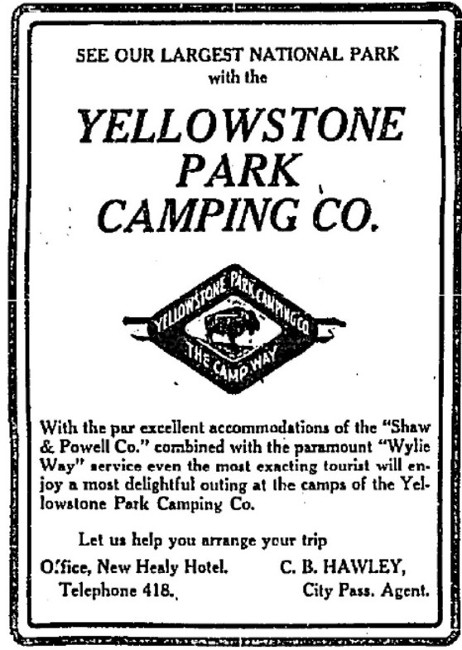 |
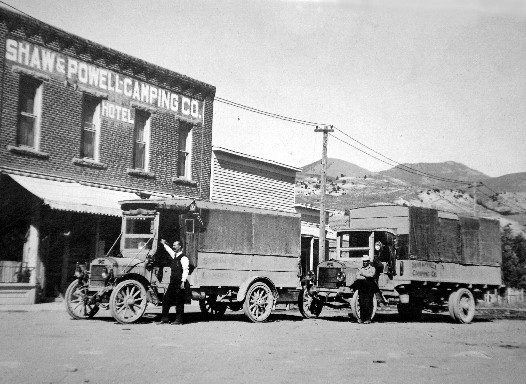
[Photo courtesy YNP Archives #127339] |
Walter Shaw and his wife Lillian operated the Shaw Hotel & Cafe from 1922-25, and Walter guided tours through the park to the Cooke City area where he operated Shaw’s Goose Lake Camp. Walter drowned in the Yellowstone River in 1925 and his family continued to operate the hotel until 1944. At that time it was sold to Hugh Crossen and J.D. Winters who operated it under the name Park Hotel and Café. They sold it to Paul Spradlin a few years later and in 1950 the hotel burned down, killing two persons. Crossen repurchased the property and built the Town Club & Café utilizing the original stone back and side walls. The property changed hands several times until 1969 when it passed into the hands of Don Laubach. The family still operates the business under the name Town Motel, Lounge, and Café. |

Remnants of metal sign still on location (hopefully) at one of the Shaw and Powell camps. |
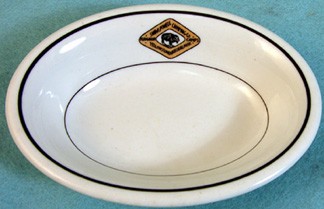
Shaw & Powell bowl used at one of the camps.
Click on photo to view a butter pat.
Click here for other views of Shaw & Powell table ware at "The Restaurant Ware Collectors Network" |
|